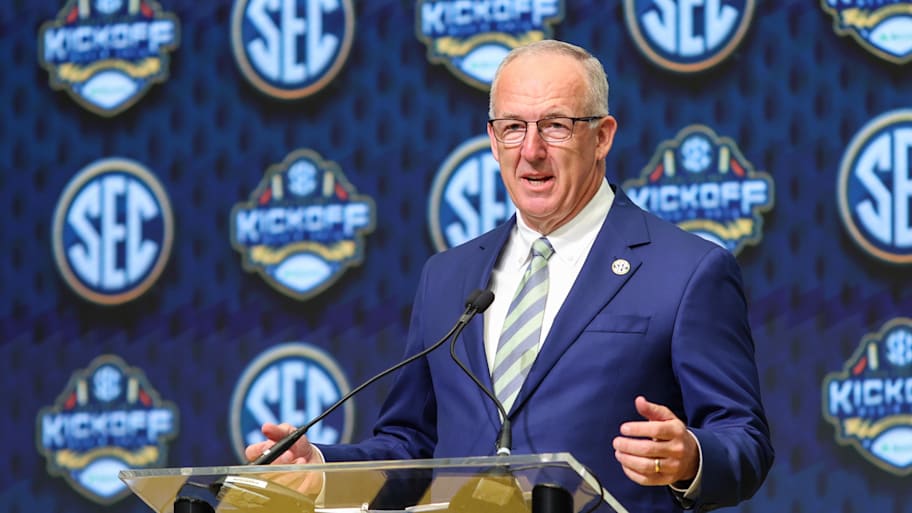ATLANTA, Ga. — Greg Sankey threw it out there, almost casually, but the premise deserves more than cursory consideration.
“We have a 12-team playoff, five conference champions,” the commissioner of the Southeastern Conference said Monday. “That can stay if we can’t agree.”
The “we” who will largely decide the future format of the College Football Playoff are Sankey and Big Ten commissioner Tony Petitti. Big 12 commissioner Brett Yormark suggested otherwise last week, asserting the SEC and Big Ten don’t have exclusive control over the format. Sankey disputed that to kick off SEC media days, saying in effect that he and Petitti are in charge.
“We have the ability to present a format or format ideas, gather information, see if we can all agree within that room,” he said. “We don’t need unanimity. Ultimately, if not, there’s a level of authority granted to the Big Ten and the SEC together, but there’s a lot to that.”
The concept of two conferences controlling the football postseason is corrosive for the sport and public trust in it. But that’s the deal the rest of FBS made with the devil, when the devil threatened to take its ball and leave.
As such, the primary stewards of the playoff could do a lot worse than maintaining a 12-team tournament instead of expanding to 14 or 16. Give it a shot. Or at least let it ride for a couple more seasons.
The first 12-teamer was a big success. The second will be better after an important tweak, going to a straight-seeding format instead of giving first-round byes to four conference champions. Letting the format breathe could be helpful, after decades of near-constant change—poll system, bowl alliance, BCS, four-team playoff, 12-team playoff, etc. Scrapping this one after two seasons keeps football fans in a state of churn and confusion, neither of which are good for loyalty.
Adding teams and adding games—while a likelihood at this point—doesn’t necessarily create a better product. The reasons for expansion are obvious: more money, first, and more teams (and leagues) that can claim a successful season.
The chance that an eventual national champion is out there lingering in spots 13 to 16 is very slim. And since those additional bids will assuredly go to power-conference teams, there is no Cinderella appeal comparable to the NCAA basketball tournament. (The power conferences want to expand that, too, which is a terrible idea. Fortunately, expansion discussions were temporarily tabled last week.)
The bigger problem than expanding for the sake of expansion is what the new format could look like in terms of automatic bids. The Big Ten has been the leader in pushing for up to four guaranteed spots, and the SEC was seen as its sidekick in that pursuit. The ACC and Big 12 would get multiple bids as well, probably two apiece.
The SEC notably shifted its stance at spring meetings in Destin, Fla., with coaches leading a push to keep automatic bids at five league champions with 11 at-large bids. We might get an idea where the reclusive Petitti stands on that next week at Big Ten media days. But in the meantime, the general stance from that league has been that the SEC needs to move from eight to nine conference games.
Which is the never-ending SEC story.
The league has dithered for years about whether to add another conference game. Programs traditionally in the bottom half of the league have opposed it, knowing that it’s likely adding a loss to their ledger that would replace a nonconference victory—potentially jeopardizing bowl eligibility. While that’s understandable, a 16-team league needs to play at least nine league games to add credibility to the standings.
They may eventually get there. Or they may still be debating it when Arch Manning’s son is playing in the league. But for now, the SEC seems intent on walking a fine line—stay at eight games and simply bludgeon the nation with strength-of-schedule rhetoric as a justification.
“I don’t believe there’s anyone looking to swap their conference schedule and its opponents with the opponents played by SEC conference teams in our conference schedule,” Sankey said. “Be it eight or nine.”
“It’s harder here” is a fine stance to take when the SEC is winning national championships, which it did annually from 2019 to ’22. But the Big Ten has won the last two, and the SEC hasn’t had a team in either of those championship games. That applies some performance pressure to the SEC this season.
To the league’s credit, some of its members are more willing to challenge themselves out of conference than others, and to do so immediately. As noted last week, Alabama, Florida and South Carolina play two power-conference opponents outside of league play, and four SEC teams open on the road against a power-conference team (Texas, Alabama, LSU and Auburn). Sixteen out of 18 Big Ten teams open at home, with the team exceptions being Nebraska in a semi-home game against Cincinnati in Kansas City and Northwestern at Tulane.
But if there is a benchmark of 10 total games against power-conference opponents and/or Notre Dame, the SEC trails far behind this season. It has three teams playing 10, while the ACC has 12, the Big Ten has 12 and the Big 12 has 14 (two of which play 11).
In sum, this might not be the ideal time for the SEC to go all in on strength of schedule. Coming off two straight non-championship seasons and continuing to play fewer power-conference games than the competition puts some doubt into that traditional argument.
The better part of Sankey’s stump speech here Monday was to raise the possibility of staying with a 12-team playoff. College football leaders are so accustomed to changing their mode of operation that they seem intent on fixing one of the few things that isn’t currently broken.
More College Football on Sports Illustrated
This article was originally published on www.si.com as SEC Commissioner Greg Sankey Says 12-Team CFP Could Remain.
